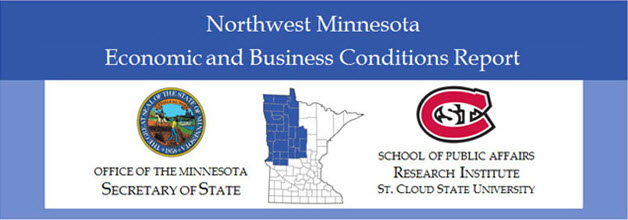Publication Title
Northwest Minnesota Economic and Business Conditions Report
Document Type
Research Study
Publication Date
2-1-2019
Abstract
Continued steady economic growth is expected in the Northwest Minnesota planning area over the next several months according to the predictions of the St. Cloud State University Northwest Minnesota Index of Leading Economic Indicators (LEI). Four of five index components increased in the most recent quarter as the LEI rose 2.26 points. An increase in the Rural Mainstreet Index (which signals a more robust macroeconomic environment for rural America) and a larger number of residential building permits in Fargo/ Moorhead and Grand Forks/East Grand Forks were among the positive components in this quarter’s leading index. A rise in the number of new filings for LLC and incorporation in Northwest Minnesota and lower regional initial jobless claims also helped drive the LEI higher. Weakness in a national consumer sentiment index was the only negative index component in the second quarter.
There were 1,327 new business filings with the Office of the Minnesota Secretary of State in Northwest Minnesota in the second quarter of 2018 — representing a 9.2 percent increase from one year ago. With 119 filings, there were 1.7 percent fewer new filings for business incorporation in the second quarter compared to the same period last year. However, new LLC filings in Northwest Minnesota were up 13 percent from one year earlier—rising to 754. New assumed names totaled 397 in the second quarter—4.2 percent more filings than the same period in 2017. There were 57 new filings for Northwest Minnesota non-profit in the second quarter—eleven more filings than one year ago.
Sixty percent of new business filers in the Northwest Minnesota planning area completed the voluntary Minnesota Business Snapshot (MBS) survey in this year’s second quarter. Results of this voluntary survey indicate that about 3.6 percent of new filers come from communities of color. Approximately 8.4 percent of new filers in Northwest Minnesota are veterans. About 2.2 percent of new filers come from the disability community and 0.9 percent of new filings in Northwest Minnesota are made by the immigrant community. Forty percent of new business filings in Northwest Minnesota in this year’s second quarter were initiated by women. MBS results also show that most new business filers in Northwest Minnesota have between 0 and $10,000 in annual gross revenues (although 108 new filers have revenues in excess of $50,000). The most popular industries for new businesses in Northwest Minnesota are construction, retail trade, real estate/rental/leasing, and other services. Employment levels at most new firms are between 0 and 5 workers, and 44.3 percent of those starting a new business consider this a part-time activity.
Employment of Northwest Minnesota residents increased by 4.3 percent over the year ending June 2018. The regional unemployment rate was 3.3 percent in June, which was considerably lower than the 4 percent rate observed one year ago. Initial claims for unemployment insurance in June 2018 were 5 percent lower than one year earlier and the Northwest Minnesota labor force increased by 4.2 percent. Average weekly wages rose 3.8 percent to $794 in the most recent annual reporting period. Northwest Minnesota’s total bankruptcies were unchanged from one year ago.
Economic performance in the Fargo/Moorhead Metropolitan Statistical Area (MSA) was mixed in the past quarter. This MSA tallied a small gain in overall employment (as well as larger job gains in the key mining/logging/construction and manufacturing sectors), increased average hourly earnings, a surge in the value of residential building permits and a lower relative cost of living. However, the Fargo/Moorhead area also experienced higher initial jobless claims, a decline in the regional workforce, flat average weekly work hours, and a rising unemployment rate. Economic activity in the Grand Forks/East Grand Forks MSA was mostly favorable in the second quarter. Higher overall employment (and increased employment in the manufacturing sector), a small increase in average hourly earnings, a rise in average weekly work hours, lower initial jobless claims and a small rise in the value of residential building permits helped improve the regional outlook in this metro area. Grand Forks/East Grand Forks also experienced a reduction in its relative cost of living. On the other hand, the area’s labor force and unemployment rate were unchanged (as was mining/logging/ construction employment).
Recommended Citation
Banaian, King and MacDonald, Richard, "Northwest Minnesota Economic and Business Conditions Report Second Quarter 2018" (2019). Northwest Minnesota Economic and Business Conditions Report. 18.
https://repository.stcloudstate.edu/qebcr_nw_mn/18




